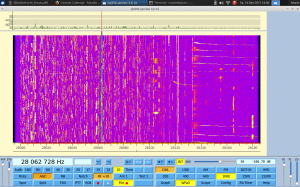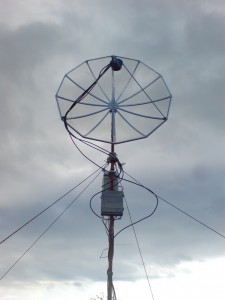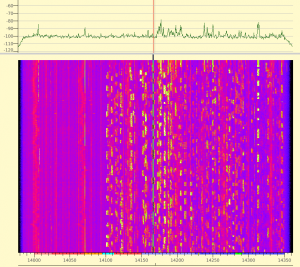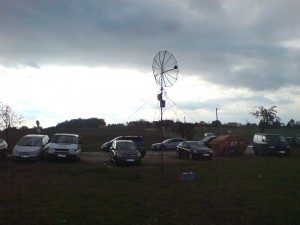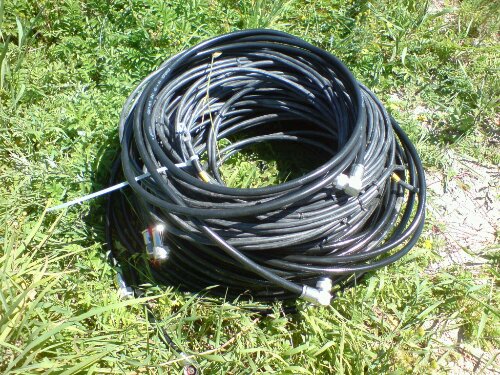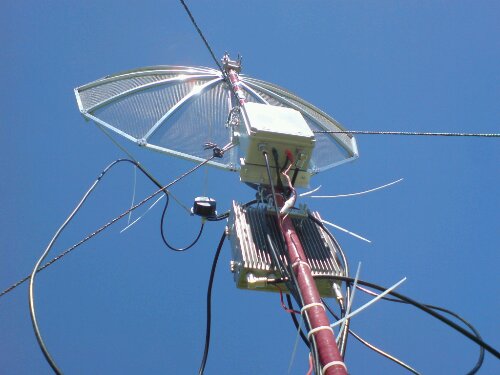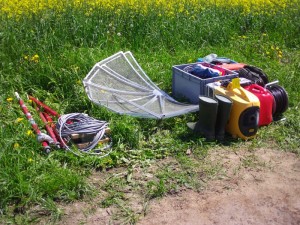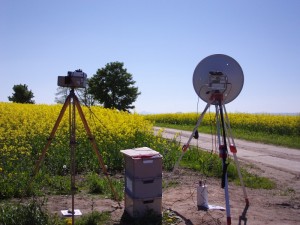I tried to build something useful out of the equipment flying around here. My HiQSDR can now transmit in CW mode via external keying. Output power is about 10W maximum. The software is quisk which can be controlled by the very nice TLF log software via the hamlib library. TLF gets spots from the reversebeacon network to fill its bandmap which is afterwards browsable via shortkey. Quisk then tunes to the station automatically. In addition TLF can use the cwdaemon to generate CW signs via a serial port. With cwdaemon running on some embedded hardware close to the HiQSDR it would be possible to have the SDR PC somewhere just connected via the wireless network running all the control and audio remote. Find a screenshot below.
Category Archives: Amateur Radio
10GHz WebSDR back
Thanks to Norbert, DL4DTU the 10GHz WebSDR is now back. It is located in Dresden, JO61VA51 with direction approximately north. The antenna is a standard LNB riffle horn. You can find the WebSDR here:
http://microwavesdr.hopto.org:8901/
Maybe it will be extended to other bands or further directions later next year.
some medium wave
Over the last weeks i sometimes listened to the 472kHz band. Some stations are calling CQ in regular CW here and there. Sometimes there is QRSS activity and you can listen to some stations using WSPR. Here is a audio snipped of one of the loudest stations here, DK7FC.
10m AARL contest ongoing…
Marconi Memorial Contest 2013
We did not have enough operators for a DM7A operation from uphill. I did not want to skip the contest completely and therefore i did the Marconi Memorial 2013 for 6 hours on sunday from Triebenberg JO61XA. The setup was somewhat unsual. I used a portabel setup consisting of my FT-857D and a HL-200V/50 and a 11ele Tonna. I had to power the station from my 1kW gererator.
Before i was a bit sceptical about the capabilities of the setup because the FT-857D is definitively not made for VHF contest operation. But since i have a narrow CW filter and the station densitiy was quite low i was lucky and faced absolutely no overdrive of the RX and almost no QRM by closeby stations.
In the end i had a total of 120QSO with about 36500 points.
One of the first qso was the ODX with IK5ZWU/6 who had a surprisingly strong signal for about 830km distance. MNI TNX Walter !
How the things develop …
Impressions from CQ-WW-SSB
DUR activity 2013 October
After 2 month of inactivity from my side another trial with 3 bands. I had 23/13/9cm with my 1.5m dish.
Meanwhile i integrated the 5W PA for 9cm. This time Murphy tried to do its very best.
I had to tear down the antenna 3 times in between. First i had troubles to find the correct lengths of the ropes for the mast.
When testing the transverters i experienced 9cm was not switching to TX. During my mast trouble i accidently disconnected the 9cm power cable at the mast unit.
After that operation was going relatively smooth. This time i was heard very well by the others on 9cm. But i experienced that my RX seems to be really poor. I always gave much better reports than i got. I did not check the sensitivity so far. Everything you dont check will not work ;)
In the end i had 17 QSO on 23cm, 9 QSO on 13cm, 5 QSO on 9cm.
ODX on 23cm was HA5UA/p. Thanks for the patience during that weak signal QSO.
Next steps with improving my setup will be a new rotator control. The original KR600 controler has some issues and i somethimes do not get correct heading. 23cm would need to be mounted to the mast. Unfortunately i dont think that i can get the mast up then. It would be too heavy.
July DUR Contest
DUR Contest May & WebSDR
This time DUR contest together with Steffen DJ5AM.
QRV on 23cm, 13cm, 10GHz, partly 24GHz.
Not very much DX on 23cm this time but some nice 10GHz QSO with the station of Steffen.
I made a short video receiving my 23cm signal with the WebSDR located at my home QTH.
The WebSDR is a test and receives 23cm & as well as 10GHz using 2x RTLSDR USB sticks.
PA3FWM kindly added support for these types of USB receiver sticks which makes it very easy to setup WebSDR receivers for the bands between 24MHz and 1700MHz. One is connected to a crystal stabilized sat LNB which makes the receiver for the narrow band section of the 10GHz ham band.
As long as the receiver is online you can find it here:
http://dh5ym.hopto.org:8901
The following pictures show my 23/13cm equipment after then end of the DUR test ready to go home and the 10GHz and 24GHz station of Steffen, DJ5AM.


